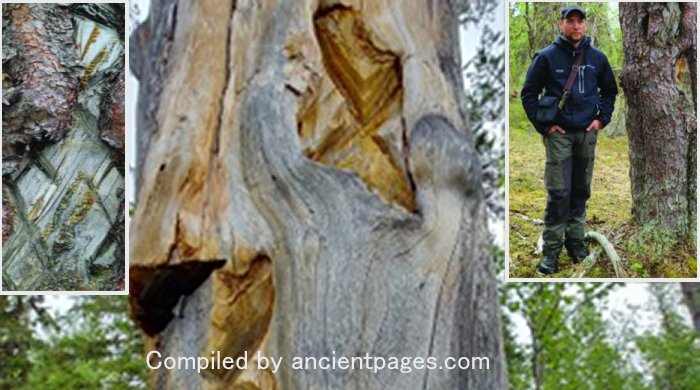Conny Waters – MessageToEagle.com – Engraved trees are living records capturing the rich history and traditions of the Sámi people. They are a vital pathway to preserving Sámi culture, the Indigenous people native to Sápmi, a region located in northern Europe.
Reindeer herder Peter Sjaggo standing next to a tree marked with crosses and geometric patterns. Credit: Lars Östlund, Swedish University of Agricultural Sciences
This area includes parts of northern Fennoscandia, which comprises Norway, Sweden, and Finland, as well as north-west Russia.
By supporting efforts to protect these natural monuments, we ensure that future generations can connect with and appreciate this unique cultural heritage.
Archaeologists analyzed trees engraved by the Indigenous Sámi of Arctic Europe, revealing the significance of these rare remnants of Sámi culture and the importance of preserving them from ongoing deforestation.
The Sámi people originally practiced an animistic religion, deeply intertwined with their cultural identity. However, a determined campaign by the Scandinavian Church in the 17th century AD resulted in the destruction of their sacred artifacts and a significant decline in their oral traditions.
This has placed their rich culture and history at serious risk.
It is imperative that we take action now to preserve and revitalize these invaluable cultural elements before they are lost forever.
A tree marked with crosses and geometric patterns. Credit: Lars Östlund, Swedish University of Agricultural Sciences
Despite the oppressive forces that sought to erase Sámi culture, one crucial element managed to endure: the marked trees scattered throughout Sápmi.
These incisions, rich with social and religious significance, stand as a testament to cultural resilience. However, it’s concerning how much of this heritage was nearly lost due to such repression.
Dr. Ingela Bergman, a co-author of the research from INSARC/Silvermuseet, stated that “unlike most other sacred objects, standing trees are not easily collected and have generally resisted the Church’s efforts to eradicate traces of Indigenous religion.”
To understand the importance of these trees, Professor Lars Östlund from the Swedish University of Agricultural Sciences, along with Dr. Bergman and Professor Olle Zackrisson from INSARC Silvermuseet, conducted a study.
Image source
They examined trees marked with Sámi symbols and compared their findings with ethnographic records of Sámi culture.
In the northern boreal forests of Fennoscandia, particularly within national parks, researchers have identified numerous Scots pine trees marked with X-marks and geometric patterns. Ethnographic studies reveal that the Sámi regarded these trees as intermediaries between humans and deities.
Additionally, they served practical purposes by functioning as boundary markers and navigational aids in the challenging, seasonal terrain of these forests.
X-marks were integral to Sámi ritual practices, where crosses were meticulously carved on antlers and reindeer blood was artfully smeared in X-shapes on sacrificial wooden objects.
Image credit: Ingela Bergman, Insarc/Silvermuseet
This compelling evidence strongly suggests that the engraving of trees with crosses occurred during offerings to deities, with these trees serving as vital mediators in the sacred rituals.
“The spiritual and pragmatic natures of trees were not mutually exclusive,” says Professor Östlund. “X-marks on trees could define a family’s territory, while simultaneously indicating its spiritual connection to the land.”
These trees hold significant symbolic value in Sámi religion and culture, yet they face considerable threats. Since the 19th century, extensive deforestation for lumber has greatly diminished the population of ancient Scots pines, including those marked with X-marks. This reduction poses a risk to both cultural heritage and environmental diversity.
Reflecting on Sápmi’s landscape before the 20th century, one envisions the thriving trees. Their decline not only poses an environmental concern but signifies a loss of generational wisdom and experience.
This connection between nature and cultural heritage highlights what is at stake as these trees disappear.
“Culturally marked trees bear silent witness to (pre)historic land use, movement patterns and sacred spaces,” conclude Dr. Bergman and Professor Östlund.
“Therefore, there is an urgent need for the documentation, interpretation and protection of all remaining culturally marked trees.”
Written by Conny Waters – MessageToEagle.com – AncientPages.com Staff Writer








